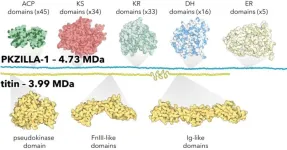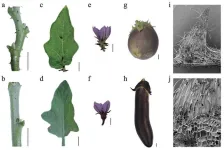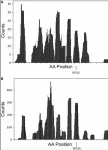(Press-News.org) Researchers at Columbia University Mailman School of Public Health, the University of North Carolina at Chapel Hill and at the National Academy of Sciences of Ukraine used the setting of the man-made Ukrainian Holodomor famine of 1932-1933 to examine the relation between prenatal famine and adult Type 2 diabetes mellitus (T2DM). They studied 128,225 Type 2 diabetes cases diagnosed between 2000-2008 among 10,186,016 male and female Ukrainians born between 1930 and 1938.
Individuals who were exposed in early gestation to the famine had a more than two-fold likelihood of developing Type 2 diabetes compared to those unexposed to the famine, according to a study led by Columbia University Mailman School of Public Health. The results are published in the journal Science.
The famine led to 4 million excess deaths in the short-term and losses were concentrated in a 6 month period. The Holodomor far exceeded other famines in terms of its intensity. Life expectancies at birth in 1933 were only 7.2 years for females and 4.3 for males.
“The Ukraine setting provided an unusual opportunity to investigate the long-term impact of the Holodomor -- or death by hunger --on Type 2 Diabetes Mellitus (T2DM) cases diagnosed seven decades after prenatal famine exposure,” said L.H. Lumey, MD, professor of Epidemiology at Columbia Public Health. “With the famine concentrated in a six-month period in early 1933, we are able to pinpoint the timing of famine together with extreme variations in intensity across provinces.”
This concentration was the result of Stalin’s use of famine as a weapon of terror against Ukrainian farmers. When Ukraine could not fulfill its grain procurement quotas to the Soviet Central Government, having not enough for themselves, drastic measures were implemented to fulfill the quotas, under the excuse that counter-revolutionary elements sabotaged grain procurement. A countrywide campaign of searches of peasant's homes looking for "hidden" or "stolen" grain was launched in late 1932 and expanded in early 1933. All or most of the food was confiscated during many of these searches, leaving families without any food for the rest of the winter. In addition, measures were implemented that curtailed Ukrainian peasants' travel in search of food.
These measures created a perfect storm. Many rural families were left without any food; avenues to search for food were closed and grain reserve funds were depleted. Thousands of rural families were condemned to a slow death by starvation in their villages. The result was an extraordinary increase in Holodomor excess deaths between January and June 1933. At the peak of the famine in June 1933, there were, on the average, 28,000 famine-related deaths per day caused by the famine, equivalent to 1,167 deaths per hour or 19 per minute.
“Our study into the long-term health impact of the Holodomor famine offers several critical lessons for addressing health challenges posed by national disasters,” observes Lumey. “It underscores the necessity for a comprehensive health care and policy framework that takes into account the lasting effects of early-life adversities on population health and their potential long-term repercussions on chronic diseases and mental health.”
While individuals diagnosed with T2DM in 2000-2008 may also be overweight or obese and have other risk factors for the disease, the relation between adult T2DM risk and the place and date of birth at the time of the famine is so specific that famine exposure in early gestation appears to be the dominant factor that overrides all others, according to the research team.
“This awareness should prompt a proactive approach among policymakers and public health officials to anticipate the increased healthcare needs among populations affected by national disasters. It also highlights the importance of raising awareness about the potential long-term health effects of early-life adversities,” observed Lumey.
“Besides the need to develop policies for addressing long-term health challenges after a national disaster, the results of our study underscore the importance of policies aimed at preventing events like the Holodomor from happening again. Russia’s invasion of Ukraine in 2022 shows that history repeats itself” points out Dr. Wolowyna of the University of North Carolina at Chapel Hill. “The three-month siege in 2022 of the city of Mariupol during the current war in Ukraine to starve the population into surrender serves as a reminder of a current and real danger. The blockade of Ukrainian ports to prevent the export of Ukrainian grain to developing countries in Africa and Asia, has increased the danger of starvation for millions of persons in these countries.”
Co-authors are Chihua Li, University of Michigan, Johns Hopkins University, and University of Macau; Mykola Khalangot, Komisarenko Institute of Endocrinology and Metabolism, Kyiv and Shupyk National Healthcare University, Kyiv; Nataliia Levchuk, 7Ptoukha Institute of Demography and Social Sciences, Kyiv and8Max Planck Institute for Demographic Research, Germany.
The study was supported by Ukraine State complex program Diabetes Mellitus, 0106U000844; the Holodomor Research and Education Consortium in Canada; NIDI-NIAS Fellowship of the Royal Netherlands Academy of Sciences; National Institute of Aging, R01 AG028593 and R01 AG06687, R01 AG070953 and R01AG075719.
The authors declare they have no competing interests.
Columbia University Mailman School of Public Health
Founded in 1922, the Columbia University Mailman School of Public Health pursues an agenda of research, education, and service to address the critical and complex public health issues affecting New Yorkers, the nation and the world. The Columbia Mailman School is the fourth largest recipient of NIH grants among schools of public health. Its nearly 300 multi-disciplinary faculty members work in more than 100 countries around the world, addressing such issues as preventing infectious and chronic diseases, environmental health, maternal and child health, health policy, climate change and health, and public health preparedness. It is a leader in public health education with more than 1,300 graduate students from 55 nations pursuing a variety of master’s and doctoral degree programs. The Columbia Mailman School is also home to numerous world-renowned research centers, including ICAP and the Center for Infection and Immunity. For more information, please visit www.mailman.columbia.edu.
END
Type 2 diabetes cases more than doubled seven decades after exposure to famine
2024-08-08
ELSE PRESS RELEASES FROM THIS DATE:
Millions of years for plants to recover from global warming
2024-08-08
In brief:
Disruption of the functioning of vegetation due to warming can lead to the failure of climate regulating mechanisms for millions of years.
Vegetation changes can alter the planet’s climate equilibrium.
Geological and climatic history provide insight into the effects of global warming today.
Scientists often seek answers to humanity’s most pressing challenges in nature. When it comes to global warming, geological history offers a unique, long-term perspective. Earth’s geological ...
The long-lasting impact of war on global diabetes prevalence
2024-08-08
[Vienna, August 7 2024] — The ongoing war between Russia and Ukraine has led to severe humanitarian crises, including widespread food shortages. According to the United Nations World Food Programme, an estimated 11 million Ukrainians—about one-third of the population—were at risk of hunger in 2023. This crisis, exacerbated by supply chain disruptions and extreme weather events, could increase diabetes prevalence not only in Ukraine but globally, argue Peter Klimek and Stefan Thurner from the Complexity Science Hub in a commentary published in the journal Science.
Malnutrition during early pregnancy is known to elevate diabetes ...
Potential new approach to enhancing stem-cell transplants
2024-08-08
August 8, 2024—(BRONX NY)—A discovery by a three-member Albert Einstein College of Medicine research team may boost the effectiveness of stem-cell transplants, commonly used for patients with cancer, blood disorders, or autoimmune diseases caused by defective stem cells, which produce all the body’s different blood cells. The findings, made in mice, were published today in the journal Science.
“Our research has the potential to improve the success of stem-cell transplants and expand their use,” explained Ulrich Steidl, ...
Largest protein yet discovered builds algal toxins
2024-08-08
While seeking to unravel how marine algae create their chemically complex toxins, scientists at UC San Diego’s Scripps Institution of Oceanography have discovered the largest protein yet identified in biology. Uncovering the biological machinery the algae evolved to make its intricate toxin also revealed previously unknown strategies for assembling chemicals, which could unlock the development of new medicines and materials.
Researchers found the protein, which they named PKZILLA-1, while studying how a type of algae called Prymnesium parvum makes its toxin, which is responsible for massive fish kills.
“This is the Mount Everest of proteins,” ...
Researchers show nanovoids improve material performance
2024-08-08
Voids or pores have usually been viewed as fatal flaws that severely degrade a material's mechanical performance and should be eliminated in manufacturing.
However, a research team led by Prof. JIN Haijun from the Institute of Metal Research (IMR) of the Chinese Academy of Sciences has proposed that the presence of voids is not always hazardous. Instead, voids can be beneficial if they are added "properly" to the material.
The team demonstrated that a metal with a large number of nanoscale voids shows improved ...
Smooth sailing for eggplant: breakthrough in understanding prickle formation
2024-08-08
Scientists have discovered the gene responsible for prickles in eggplants, a trait that complicates farming. Using advanced genetic techniques, they identified the Prickly Eggplant (PE) gene on chromosome 6 and pinpointed SmLOG1 as the key factor. CRISPR-Cas9 gene editing confirmed that disabling SmLOG1 eliminates prickles, paving the way for prickle-free eggplant varieties. This breakthrough not only sheds light on prickle development but also promises to streamline eggplant cultivation and harvesting, benefiting the agricultural industry.
Eggplants, a staple crop globally, present significant challenges in cultivation and harvesting due to their prickles. These prickles, which serve as ...
Eating for necessity or pleasure? There is a brain circuit for that
2024-08-08
People eat either because they are hungry or for pleasure, even in the absence of hunger. While hunger-driven eating is fundamental for survival, pleasure-driven feeding may accelerate the onset of obesity and associated metabolic disorders. A study published in Nature Metabolism reveals neural circuits in the mouse brain that promote hunger-driven feeding and suppress pleasure-driven eating. The findings open new possibilities for developing strategies to combat obesity.
“Ideal feeding habits would balance eating for necessity and for pleasure, minimizing the latter,” said co-corresponding author Dr. Yong Xu, ...
TCR CDR3s and renalase-1 linked to increased melanoma survival
2024-08-08
“These findings indicate that renalase-1 is a potential antigen for TCR recognition in melanoma and could be considered as a target for immunotherapy.”
BUFFALO, NY- August 8, 2024 – A new research paper was published in Oncotarget's Volume 15 on August 5, 2024, entitled, “Chemical complementarity of tumor resident, T-cell receptor CDR3s and renalase-1 correlates with increased melanoma survival.”
As mentioned in the Abstract of this study, overexpression of the secretory protein renalase-1 negatively impacts the survival of melanoma and pancreatic cancer patients, while inhibition of renalase-1 signaling drives tumor ...
Department of Energy announces $4.6 million to fund public-private partnerships for fusion research
2024-08-08
Key Takeaways
-Fusion has the potential to provide abundant clean energy
-One to two-year awards range from $100,000 to $500,000
In a continuing effort to forge and fund public-private partnerships to accelerate fusion research, the U.S. Department of Energy (DOE) today awarded $4.6 million in 17 awards to U.S. businesses via the Innovation Network for Fusion Energy (INFUSE) program.
The goal of INFUSE is to accelerate fusion energy development in the private sector by reducing impediments to collaboration between business ...
Want to feel less stressed? Try the Mediterranean diet
2024-08-08
Following the Mediterranean diet versus the traditional Western diet might make you feel like you’re under less stress, according to new research conducted by a team from Binghamton University, State University of New York.
The findings suggest that people can lower their perception of how much stress they can tolerate by following a Mediterranean diet, said Lina Begdache, associate professor of health and wellness studies.
“Stress is recognized to be a precursor to mental distress, and research, including our own, has demonstrated that the Mediterranean diet lowers ...





